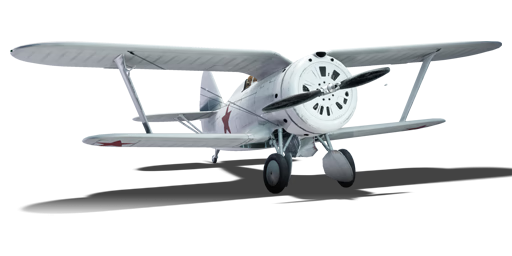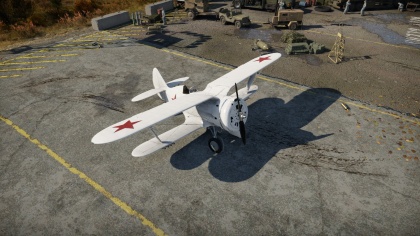Zhukovsky's I-153-M62
Contents
| This page is about the Russian biplane Zhukovsky's I-153-M62. For other uses, see I-15 (Family). |
Description
Zhukovsky's I-153-M62 is a premium Rank I Soviet biplane
with a battle rating of 2.0 (AB/SB) and 2.3 (RB). It was introduced in Update 1.31. It costs 250 Golden Eagles. The plane is painted after the camouflage scheme of Soviet pilot Sergey Y. Zhukovsky in the 127th Fighter Aviation Regiment of the Soviet Air Forces.
The main purpose of the 153 Chaika is to support operations as an escort, air superiority, or ground attack fighter aircraft. It is best used, however, as an air superiority aircraft. Due to its fast climb rate, tight turning radius, and speed, it outperforms many of its contemporaries. Tactically, climb high at the start of a match to pursue bombers or other fighters by diving on them, targeting engines and fuel tanks.
Once the threat of enemies at altitude is removed, or when engaging bombers such as the PBY, H6K, Blenheim, or Beaufort, it is highly advisable to kill the gunners of the aircraft and force it to dive, and begin targeting the engines and wings. Against fighters, head-oning is an OK strategy if you disengage and loop around onto the hostile aircraft. At low altitudes, the turning capabilities of the aircraft, coupled with its excellent climb rate, allow you to attack and retreat at will.
Zhukovsky's Chaika is a distinctive vehicle in mainly appearance. It performs very well and can take bombs and rockets into battle. With a forward armament of 4 x 7.62 mm ShKAS machine guns, it can quite quickly ruin enemy planes, and its payload options allow it to deal with a couple lightly armoured vehicles while it's over the battlefield.
General info
Flight Performance
Describe how the aircraft behaves in the air. Speed, manoeuvrability, acceleration and allowable loads - these are the most important characteristics of the vehicle.
| Characteristics | |||||||
|---|---|---|---|---|---|---|---|
| Stock | |||||||
| Max Speed (km/h at 4,850 m) |
Max altitude (meters) |
Turn time (seconds) |
Rate of climb (meters/second) |
Take-off run (meters) | |||
| AB | RB | AB | RB | AB | RB | ||
| 421 | 409 | 10,700 | 14.1 | 14.4 | 11.3 | 11.3 | 274 |
| Upgraded | |||||||
| Max Speed (km/h at 4,850 m) |
Max altitude (meters) | Turn time (seconds) | Rate of climb (meters/second) |
Take-off run (meters) | |||
| AB | RB | AB | RB | AB | RB | ||
| 466 | 444 | 10,700 | 13.0 | 13.3 | 24.2 | 15.2 | 274 |
Details
| Features | ||||
|---|---|---|---|---|
| Combat flap | Take-off flap | Landing flap | Air brakes | Arrestor gear |
| X | X | X | X | X |
| Limits | ||||
|---|---|---|---|---|
| Wing-break speed (km/h) |
Gear limit (km/h) |
Combat flap (km/h) |
Max Static G | |
| + | - | |||
| 570 | 570 | ??? | ~14 | ~14 |
| Optimal velocities | |||
|---|---|---|---|
| Ailerons (km/h) |
Rudder (km/h) |
Elevators (km/h) |
Radiator (km/h) |
| < 300 | < 340 | < 340 | > 220 |
| Compressor (RB/SB) | ||
|---|---|---|
| Setting 1 | ||
| Optimal altitude | 100% Engine power | WEP Engine power |
| 2,500 m | 930 hp | 1,116 hp |
| Setting 2 | ||
| Optimal altitude | 100% Engine power | WEP Engine power |
| 5,000 m | 880 hp | 1,056 hp |
Survivability and armour
- 8 mm Steel plate behind the pilot.
- No armour glazing, open cockpit
- Critical components located at front of aircraft (fuel, pilot, engine, controls)
Armaments
Offensive armament
Zhukovsky's I-153-M62 is armed with:
- 4 x 7.62 mm ShKAS machine gun, nose mounted (750 + 520 + 500 + 700 (Top right clockwise) = 2,470 total)
Suspended armament
Zhukovsky's I-153-M62 can be outfitted with the following ordinance:
- Without load
- 4 x 50 kg FAB-50 bombs (200 kg total)
- 8 x 82 mm RS-82 rockets
- 8 x 82 mm RBS-82 rockets
Usage in battles
As described earlier, climbing at an aggressive rate during the beginning of the game is extremely beneficial. Once at bomber altitude, building up speed is a must as the biplane bleeds speed in high altitude turns. However, once this is achieved, the plane has free reign over ruling the sky. Play mainly as an interceptor and air-defense fighter and watch as the enemy plummets towards the ground.
Anything with .50 cals will usually knock your engine out almost immediately. Also, tracer belts easily light this on fire, and the burning is usually fatal. As a result, turn-fighting to keep yourself out of enemy guns is advisable.
Many aircraft will attempt to boom and zoom you if you remain at low altitudes. Should this happen, engage as though you were going to head-on and break off at the last moment. By swinging around, you'll be able to catch them as they pull up and destroy them.
Manual Engine Control
| MEC elements | ||||||
|---|---|---|---|---|---|---|
| Mixer | Pitch | Radiator | Supercharger | Turbocharger | ||
| Oil | Water | Type | ||||
| Controllable | Not controllable | Not controllable | Not controllable | Separate | Not controllable | Not controllable |
Modules
| Tier | Flight performance | Survivability | Weaponry | ||
|---|---|---|---|---|---|
| I | Fuselage Repair | Radiator | Offensive 7 mm | DZ-40 | |
| II | Compressor | Airframe | RO-82 | ||
| III | Wings Repair | Engine | New 7 mm MGs | ||
| IV | Engine Injection | Cover | |||
- As Zhukovsky's I-153-M62 is a premium vehicle, it comes will all modules researched.
Pros and cons
Pros:
- Incredible turn radius
- Great climb rate
- High rate of fire with 4 7.62 mm machine guns
Cons:
- Low speed
- Minimal damage output with default belts for the 7.62 mm machine guns
History
Describe the history of the creation and combat usage of the aircraft in more detail than in the introduction. If the historical reference turns out to be too big, take it to a separate article, taking a link to the article about the vehicle and adding a block "/ History" (example: https://wiki.warthunder.com/(Vehicle-name)/History) and add a link to it here using the main template. Be sure to reference text and sources by using <ref>, as well as adding them at the end of the article. This section may also include the vehicle's dev blog entry (if applicable) and the in-game encyclopedia description (under === Encyclopedia Info ===, also if applicable).
In-game description
"The I-153P Chaika (Seagull) was a Soviet biplane fighter of the 1930s and 1940s. It was created by the Polikarpov Design Bureau in 1938. It is a modification (3rd variant) of the earlier I-15 fighter, as shown in the designation. The Chaika was considered to be the fastest biplane in the world. However, at the start of hostilities between the Soviet Union and Germany, the I-153 could not compete on equal terms with the German Messerschmitt Bf-109 and therefore was mainly used in ground attack roles.
For many years, Soviet pilots considered the I-16 to be the most dangerous aircraft in a spin. Therefore, when flight testing the I-153 with the M-25 engine in March and April of 1939, the VVS Command paid special attention to its spin characteristics. Initially, the matter remained unresolved. However, in the summer of 1939, when the new aircraft saw action against the Japanese in Mongolia, NII VVS returned to this crucial point. Test results were disappointing. By the third full rotation the I-153 would go into a flat spin; the engine would cease by the fifth formation, after which spin recovery would become extremely difficult. Lowering the landing gear in order to shift the center [sic] of gravity did not help. The Chaika still took a significant amount of time to recover."
Media
Excellent additions to the article would be video guides, screenshots from the game, and photos.
See also
Links to the articles on the War Thunder Wiki that you think will be useful for the reader, for example:
- reference to the series of the aircraft;
- links to approximate analogues of other nations and research trees.
External links
Paste links to sources and external resources, such as:
- topic on the official game forum;
- encyclopedia page on the aircraft;
- other literature.
| USSR fighters | |
|---|---|
| I-15 | I-15 WR · I-15 M-22 · I-15 M-25 · I-15bis · Krasnolutsky's I-15bis |
| I-153 M-62 · Zhukovsky's I-153-M62 · I-153P | |
| I-16 | I-16 type 5 · I-16 type 10 · I-16 type 18 · I-16 type 24 · I-16 type 27 · I-16 type 28 · I-180S |
| I-29 | I-29 |
| I-185 | I-185 (M-71) · I-185 (M-82) |
| I-225 | I-225 |
| ITP | ITP (M-1) |
| MiG-3 | MiG-3-15 · MiG-3-15 (BK) · MiG-3-34 |
| LaGG | I-301 · LaGG-3-4 · LaGG-3-8 · LaGG-3-11 · LaGG-3-23 · LaGG-3-34 · LaGG-3-35 · LaGG-3-66 |
| La | La-5 · La-5F · La-5FN · La-7 · Dolgushin's La-7 · La-7B-20 · La-9 · La-11 |
| Yak-1/7 | Yak-1 · Yak-1B · Yak-7B |
| Yak-3 | Yak-3 · Eremin's Yak-3(e) · Yak-3P · Yak-3T · Yak-3U · Yak-3 (VK-107) |
| Yak-9 | Yak-9 · Yak-9B · Golovachev's Yak-9M · Yak-9T · Yak-9K · Yak-9U · Yak-9UT · Yak-9P |
| Other countries | ▂P-40E-1 · ▂P-47D-27 · ▂Hurricane Mk IIB · ▂Fw 190 D-9 · ▂Spitfire Mk IXc |
| P-39 | ▂P-39K-1 · ▂Pokryshkin's P-39N-0 · ▂P-39Q-15 |
| P-63 | ▂P-63A-5 · ▂P-63A-10 · ▂P-63C-5 |





